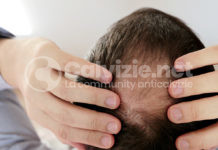What is hirsutism? Hirsutism is the medical term for excess body or facial hair in women. It can easily be described as a male hair growth pattern or distribution on a female body. Hirsutism is considered a disease by many medical authorities and can be the result of a serious underlying disorder that can be easily be ruled out with a medical history and some simple blood tests. Hirsutism is usually caused by an increased production of a group of hormones called androgens (“male hormones”) or an increased sensitivity of the skin to these hormones. Androgen disorders affect between 5% to 10% of all women. Women with hirsutism have an increased production rate of testosterone and androstenedione.
What is hypertrichosis? Hypertrichosis is usually described as an excessive quantity of hair in a normal location on one’s body compared to others of the same sex, age, and ethnic background. Men usually have hair on their chest. If a man had a lot of hair on his chest, it would be called hypertrichosis. But a woman with a full beard would be called hirsute. Women do not normally have a beard. When a woman has a lot of hair on the calf of the leg, it would not be called hirsutism but hypertrichosis. Women normally have hair on their calves. Women who have a few chin hairs and a few upper lip hairs would be called hypertrichotic but not hirsute.
What is hyperandrogenism? Hyperandrogenism is increased levels of male hormone production in women. The causes of hyperandrogenism and hirsutism in women are as follows:
- Chronic anovulation – i.e. polycystic ovarian syndrome
- Idiopathic hirsutism – excess hair growth with normal menstrual cycles and normal androgen (male hormone) levels
- Late onset congenital adrenal hyperplasia – an inherited disorder of hormone metabolism that causes increased hair growth in women after puberty
- Ovarian tumors – a rare cause of hirsutism
- Adrenal causes – more rare cause of hirsutism
- Pregnancy related – also rare, e.g. luteoma of pregnancy (tumor derived from the corpus luteum cells of the ovary)
- Drugs – some drugs can cause excess hair growth in women
The most commonly seen clinical problem is irregular menstrual cycles (anovulation), onset of hirsutism in the teens or early 20s, and gradually worsening excess hair growth. These are the findings associated with the condition known as polycystic ovarian syndrome.
Treatments for hyperandrogenism range from oral contraceptives to Spironolactone to Flutamide. Testosterone (T) levels should be tested and a tumor workup should be done if the total testosterone is over 200 ng/dl. Additional tests such as Dehydroepiandrosterone sulfate (DHEAS), 17-hydroxyprogesterone for CAH, prolactin, T4, TSH, breast exam, and an endometrial biopsy may be indicated.
For most women, the tendency towards hirsutism is inherited. Excess hair growth may be present in both the female and male family members. Hirsutism usually begins around puberty, but mild hirsutism can start at any age. Most women gradually develop more facial or body hair with age. In the recent past, unwanted hair has been considered a “taboo” topic of conversation and therefore, many affected women did not realize how common their problem was. At least 25% and as much as 85% of normal middle-aged women remove unwanted facial and body hair, although few of these women are termed hirsute.
(source: keratin.com)
































